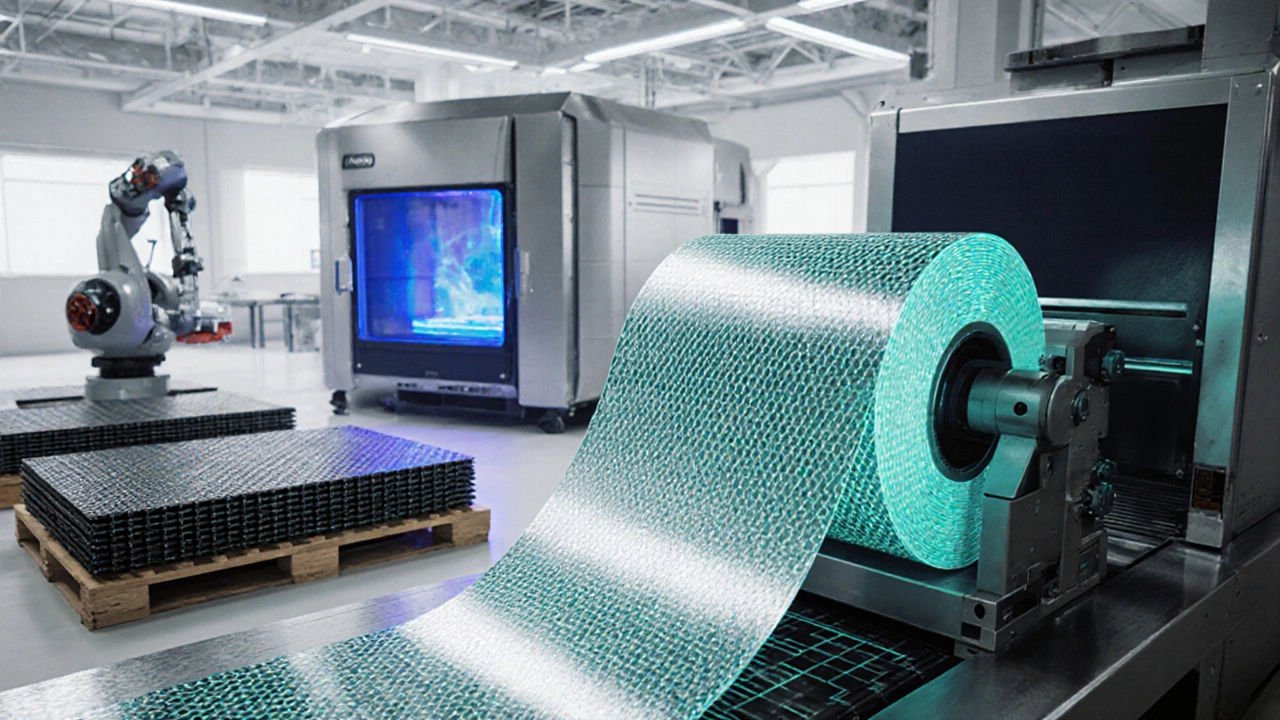Current State of Nanotechnology in 2025 - How Advanced Is It?
 Oct, 8 2025
Oct, 8 2025
Nanotechnology Sector Maturity Tracker
Explore the maturity and revenue of key nanotechnology sectors in 2024. Click on a sector to learn more about its characteristics.
Revenue: $12.4 billion
Maturity: High
Leading the field with FDA-approved nanocarriers for drug delivery and diagnostics.
Revenue: $8.9 billion
Maturity: Medium-High
Pioneering silicon-nanowire anodes for advanced battery technology.
Revenue: $22.1 billion
Maturity: High
Essential for modern chip fabrication with ALD and DSA technologies.
Revenue: $5.3 billion
Maturity: Medium
Driving innovation with graphene, carbon nanotubes, and quantum dots.
Sector Comparison Summary
Based on 2024 data, the semiconductor manufacturing sector leads in revenue at $22.1 billion, while nanomedicine holds the highest maturity level with FDA approvals for nanocarriers.
The energy and storage sector shows strong growth potential with scalable applications in battery technology, while advanced materials continues to drive innovation across multiple industries.
Key Insights:
- Nanomedicine has the highest regulatory maturity and consumer acceptance
- Semiconductor manufacturing drives the largest revenue despite high technical complexity
- Energy applications are rapidly scaling with promising early commercialization
- Advanced materials are foundational to emerging nanotech applications
Key Takeaways
- Nanotechnology is now a production‑scale field, with billions of dollars in annual revenue.
- Medicine, energy storage, and semiconductor manufacturing lead the maturity chart.
- Carbon nanotubes, graphene, and quantum dots dominate commercial nanomaterials.
- Manufacturing techniques like atomic layer deposition and directed self‑assembly have shrunk production costs by 40% since 2020.
- Regulatory, safety, and scaling challenges still hold back large‑scale nanorobotics and environmental applications.
Nanotechnology is a multidisciplinary field that manipulates matter at the scale of atoms and molecules-typically between 1 and 100 nanometres-to create new materials, devices, and systems. In the last five years the discipline has moved from niche research labs into the factory floor, the clinic, and even everyday consumer products. This article walks through the most visible breakthroughs, the sectors where nanotech is truly mature, the hurdles that still need solving, and what the next decade could look like.
Recent Breakthroughs That Redefined the Field
The year 2023 saw the commercial launch of the first large‑area graphene roll‑to‑roll printer, enabling flexible conductive films for wearable electronics. By 2024, quantum‑dot displays captured 15% of the TV market, offering higher colour gamut and lower power draw than traditional OLED panels.
In biomedicine, nanomedicine refers to the use of nanoscale carriers to deliver drugs, diagnose disease, or perform minimally invasive therapies earned FDA approval for a lipid‑nanoparticle mRNA vaccine booster, proving that nanocarriers can meet stringent safety standards at scale.
On the manufacturing side, atomic layer deposition (ALD) achieved sub‑nanometre thickness control across 300‑mm wafers, a feat that shaved 30% off the cost of high‑k dielectric layers used in modern CPUs. Directed self‑assembly (DSA) of block copolymers is now being piloted by two leading semiconductor fabs to push pattern pitches below 10nm without extreme‑uv lithography.
Core Application Domains
Not every nanotech venture is created equal. Below is a snapshot of the four biggest domains, ordered by market maturity and revenue.
| Sector | Maturity Level | 2024 Global Revenue (USDbn) | Key Players |
|---|---|---|---|
| Nanomedicine | High | 12.4 | Moderna, Pfizer, NanoString |
| Energy & Storage | Medium‑High | 8.9 | Panasonic, AMS, Tesla |
| Semiconductor Manufacturing | High | 22.1 | TSMC, Intel, Samsung |
| Advanced Materials (graphene, CNTs, quantum dots) | Medium | 5.3 | Versarien, Nantero, Quantum Solutions |
Medicine leads the pack because regulatory pathways have finally caught up with the science. Energy applications-like silicon‑nanowire anodes for lithium‑ion batteries-are still scaling, but pilot lines in Asia and Europe already ship commercial cells.
In the semiconductor world, nanofabrication techniques are indispensable for keeping Moore’s Law alive. The transition from 7nm to 5nm chips relied heavily on high‑k dielectrics grown by ALD, a quintessential nanotech process.
Nanomaterials That Power Today’s Products
Carbon nanotubes are cylindrical sheets of graphene that combine exceptional tensile strength with high electrical conductivity have found a niche in lightweight composite panels for aerospace. Since 2022, at least three commercial aircraft manufacturers have certified CNT‑reinforced polymer parts for non‑critical structures.
Graphene is a single layer of carbon atoms arranged in a hexagonal lattice, known for its extraordinary conductivity and mechanical strength is now sold in roll form for flexible printed circuits. The market for graphene inks alone crossed $600million in 2024, driven by smart‑label and IoT sensor makers.
Quantum dots are semiconductor nanocrystals that emit light of precise wavelengths when excited, enabling ultra‑bright displays dominate the high‑end TV segment, with Samsung and LG reporting a combined shipment of 20million units in 2024.
Manufacturing and Fabrication Advances
Scaling nanotech from the benchtop to mass production required a rethink of how we build at the atomic level. Two technologies stand out:
- Atomic Layer Deposition (ALD): A sequential, self‑limiting chemical reaction that deposits one atomic layer per cycle. Modern ALD tools can coat 300‑mm wafers in under 30minutes, delivering sub‑nanometre uniformity.
- Directed Self‑Assembly (DSA): Uses block copolymers that spontaneously form regular patterns when heated. When guided by a top‑coat template, DSA can create features smaller than 10nm without expensive lithography upgrades.
Both methods have slashed material waste by roughly 40% compared with traditional vapor‑phase techniques. Moreover, they integrate well with existing fab lines, meaning manufacturers can adopt them without a full plant overhaul.

Challenges, Risks, and Ethical Concerns
Despite the hype, nanotech still grapples with three major obstacles.
- Safety and Regulation: Inhalation of airborne nanoparticles can trigger unforeseen health effects. The European Union’s REACH amendment in 2023 introduced a mandatory risk‑assessment framework for nano‑enabled products, but enforcement varies across member states.
- Scalability: While lab‑scale synthesis of nanorobotics refers to tiny machines capable of performing tasks at the cellular level is impressive, producing millions of functional units remains prohibitively expensive.
- Public Perception: Media portrayals of “grey goo” and uncontrolled nanobots still color public opinion. Transparent communication and third‑party certifications are becoming essential for market acceptance.
Addressing these issues calls for interdisciplinary collaboration-materials scientists, toxicologists, policymakers, and ethicists must work together.
Looking Ahead: The Next Decade of Nanotechnology
What will 2030 look like if current trends hold?
- Personalized Nanomedicine: Expect to see nanocarriers that sense a patient’s biomarkers in real time and adjust drug release on the fly, cutting side‑effects by up to 70%.
- Quantum‑Ready Materials: Nanostructured superconductors and topological insulators could become the backbone of practical quantum computers.
- Smart Infrastructure: Embedding nanosensors tiny devices that monitor temperature, stress, or chemical composition at the molecular level into bridges and pipelines will enable predictive maintenance, reducing failures by an estimated 30%.
- Carbon‑Neutral Manufacturing: By replacing traditional energy‑intensive processes with low‑temperature plasma nanofabrication, the industry could cut its carbon footprint by nearly half.
These scenarios hinge on continued investment in research, clearer regulatory pathways, and public trust. The momentum is there; the next ten years will decide whether nanotech stays a niche marvel or becomes a cornerstone of everyday life.
Frequently Asked Questions
What is the difference between nanotechnology and nanomaterials?
Nanotechnology is the broader discipline that designs, creates, and manipulates structures on the nanoscale. Nanomaterials are the actual substances-like carbon nanotubes or quantum dots-produced using those techniques.
Are nanotech products safe for consumers?
Safety depends on the specific material and its exposure route. Regulatory bodies such as the FDA and EU’s REACH have established testing protocols for inhalation, ingestion, and skin contact. Products that have passed these tests, like FDA‑approved nanomedicines, are considered safe for use.
How are carbon nanotubes used in everyday life?
Beyond aerospace composites, carbon nanotubes appear in high‑performance sports equipment, conductive inks for printed RFID tags, and even in some high‑end headphones to improve speaker diaphragm strength.
Will nanorobots be used for medical surgeries?
Clinical trials are underway for nanorobotic drug delivery systems, but fully autonomous surgical nanobots are still in the prototype stage. Scaling production and ensuring reliable control are the main hurdles before they reach the operating room.
How does nanotechnology impact renewable energy?
Nanostructured catalysts boost the efficiency of hydrogen production via electrolysis, while nanowire anodes increase the energy density of lithium‑ion batteries, enabling longer‑lasting solar storage systems.